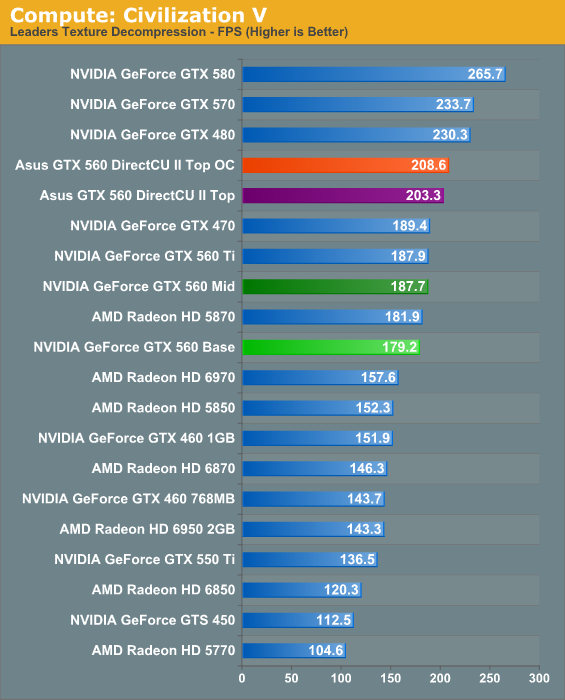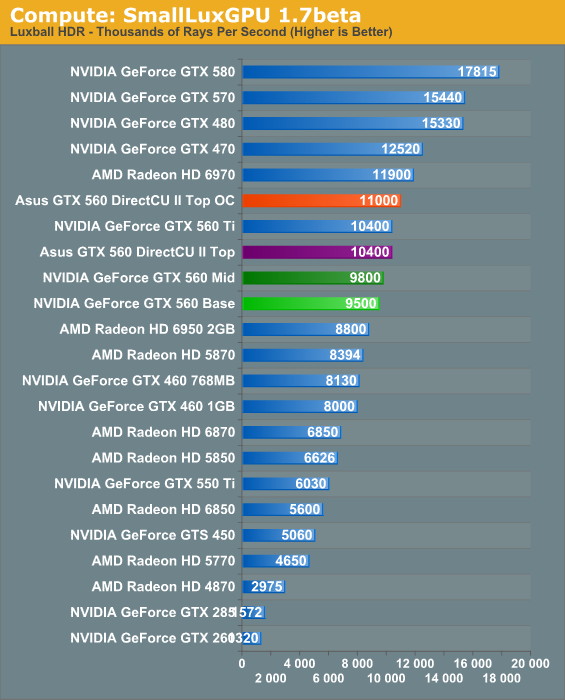NVIDIA's GeForce GTX 560: The Top To Bottom Factory Overclock
by Ryan Smith on May 17, 2011 9:00 AM ESTCompute Performance
Moving on from our look at gaming performance, we have our customary look at compute performance. Since compute performance is by definition shader bound, the GTX 560 is at a bit of a disadvantage here. Whereas the higher clocked ROPs would offset some of the GTX 560 Ti’s gaming lead, here the GTX 560 has nothing to stand on besides raw shader power.
Our first compute benchmark comes from Civilization V, which uses DirectCompute to decompress textures on the fly. Civ V includes a sub-benchmark that exclusively tests the speed of their texture decompression algorithm by repeatedly decompressing the textures required for one of the game’s leader scenes. Note that this is a DX11 DirectCompute benchmark.

This benchmark threw us for a bit of a loop, and we ended up running it several more times just to be sure. Under most circumstances the texture decompression test should be shader bound, but here it’s not – or at least not entirely. The GTX 560 Mid and GTX 560 Ti basically tie here, which is quite odd since the GTX 560 Ti has quite a shader advantage due to the 8th SM. As best as we can tell, either texture decompression doesn’t scale well with SMs, or it’s memory bandwidth bound at some point, with the latter case being the more likely of the two.
In any case as a result the GTX 560 Mid does quite well here, and the ASUS GTX 560 with its factory overclock shoots right past everything short of the 480/570/580. We’ll have to see if this weird outcome holds up in our other compute benchmark.
Our second compute benchmark of the day is SmallLuxGPU, the GPU ray tracing branch of the open source LuxRender renderer. While it’s still in beta, SmallLuxGPU recently hit a milestone by implementing a complete ray tracing engine in OpenCL, allowing them to fully offload the process to the GPU. It’s this ray tracing engine we’re testing.

Under SmallLuxGPU the GTX 560 behaves much more like we’d expect it to. The GTX 560 Mid does well, but it still falls behind the GTX 560 Ti as we’d expect. Keeping in mind that the theoretical difference should be around 10% in favor of the GTX 560 Ti however, the GTX 560 Mid still does a bit better than we were expecting, letting the GTX 560 take off with only a 6% lead. Compared to the GTX 460 however the difference is almost exactly what we’d expect it to be: the GTX 560 Mid is ahead by 23%.
Overall our compute results leave us a bit surprised: while extra shaders are normally extremely beneficial on compute benchmarks, that’s not entirely the case here. The GTX 560 series was never meant to be a compute powerhouse like the GTX 570/580, but if compute performance is a factor in your purchasing decision then it looks like you aren’t giving up much moving from a GTX 560 Ti to a GTX 560 Mid.










66 Comments
View All Comments
Ryan Smith - Tuesday, May 17, 2011 - link
We always include MIRs in our pricing, given their prevalence. With MIRs, there are no fewer than 6 6870s at Newegg below $180 (and a 7th at $183).C'DaleRider - Wednesday, May 18, 2011 - link
"I don't know where you guys are getting this information, but the Radeon HD 6870 IS NOT at $180."Actually, I don't know where YOU are getting your misinformed information.
Right now, on Newegg, 6870's are as low as $162 after rebate, $182 before rebate. (An XFX card, btw.)
Take a look......
http://www.newegg.com/Product/ProductList.aspx?Sub...
Now, maybe you'll get your facts correct before posting drivel.
L. - Thursday, May 19, 2011 - link
Don't feed teh trollz ;)Stas - Wednesday, May 18, 2011 - link
Idk, I paid $160 for my Sapphire HD6870 with dual fans 2 months ago o.Oaraczynski - Tuesday, May 17, 2011 - link
...would those 'in the know' know whether games like the witcher2 and skyrim would be better off with the nvidia or amd line?TheJian - Wednesday, May 18, 2011 - link
Witcher 2 doesn't use Aurora engine, all new now so wait for it to be put in some sites benchmarking. Same with skyrim, it uses a new Creation engine, and also 100% dynamic lighting with lots of snow and cliffs (which this engine is designed for).Sorry. Not much worth extrapolating other than we have no idea who will win later :) If we're being honest anyway. I suppose a quick google might get a hit on the devs opinions.
Sunsmasher - Tuesday, May 17, 2011 - link
Your comments about confusing naming are very valid.I've long ago come to the conclusion that the confusing naming issue is a deliberate strategy by Nvidia.
They WANT to create confusion to make it more difficult for less sophisticated buyers
to compare cards head to head and Nvidia can thereby pick up a few more sales than they would otherwise.
The proof that this is deliberate is the fact that they Keep Doing It.
Otherwise, they would have very straightforward, very easily compared naming conventions:
Higher numbers = more power, GT not as powerful as GTX, etc.
An unfortunate state of affairs, but not about to change even with writers often complaining about it.
Fortunately, there are resources on the web that compare cards head to head.
TheJian - Wednesday, May 18, 2011 - link
They're not trying to confuse you. They're just trying to sell every chip they can. A lot of dies have defects etc that cause them to release a plethora of cards at different speeds, features disabled (possibly due to defects in dies) etc. Die shrinks cause problems too. Sometimes they save enough in power/heat to warrant a new release # or model. Take the GTX 260. The core216 came out, fixed heat issues and was a good 10% faster. People would want to identify the faster/cooler cards and not get screwed. I hate Motherboard makers not listing the REV prominently on the box, or in ads. It's tough to buy online when I'm after a specific rev. This is more a tech issue than a company deliberately ticking us off.If you don't mind paying MUCH higher prices, they can go ahead an toss all defective dies and get back to 3 product lines with easily seen performance advantages between the 3. AMD, Intel, Nvidia, etc they all have this problem. Of course progress would really slow down if they take this route. A person going into the store and seeing a 6750 card, might find a 5850 sitting next to it for $200 and wonder what the heck is going on...LOL. I could almost say the same about the 6850. That 6850 should blow away a 5850, I mean its a whole 1000 higher right? Confusing yes? But that 5850 beats the 6850 by about 10% in everything. There are a lot of these examples. Heck this time NV let the manufacturers decide everything (clock/memory/ref design).
In an age of small margins, just about everything in your PC being a commodity, and shareholders demanding every last dollar they can get from company X, you should just get used to tons of products not performing too differently. Really, I can make up my mind in one night of reading reviews on 3-4 websites. By the end of the night I can decide how to spend my money and be fairly certain I'm not making a big mistake. But yeah, if you're not willing to do some homework, get ready to buy something that's completely disappointing on occasion. But you're already here, no worries :) We have hardware review sites, because stores shelves and floor reps at fry's don't help us at all... :) I pity marketing dept's trying to work with all these dies/re-launches/binning etc that probably cause them nightmares...LOL Could they do better here and there? Probably. Would I like to try to make us all happy? HECK NO. :) I take that back, I wouldn't mind taking a crack at intel naming. :)
sysdawg - Tuesday, May 17, 2011 - link
Ryan,Thanks for your reviews. On page 3 you write "on the ATI side we’re using the Catalyst 11.5a hotfix"...but is that the case for all the AMD cards? The same page lists three drivers being used: Catalyst 10.10e, 11.4, and 11.5a. And for the Nvidia cards, you also list three drivers: 262.99, 270.51 beta, and 275.20 beta. If you could help, I'd specifically like to know which drivers were used for the GTX 580 and the Radeon 6970. And since I'm going to be running at 2560x1600, it would also help to know which drivers were used for those 2 cards in your March 24 review (of the GTX 590), since that review included that resolution. My thinking is that if the drivers are reasonably current for both cards, then it is closer to being 'apples to apples'.
Thanks in advance, and thank you again for your reviews.
Ryan Smith - Wednesday, May 18, 2011 - link
Cat 10.10e: Radeon 3xxx/4xxx.Cat 11.4: Radeon 5xxx/6850/6970
Cat 11.5: Radeon 6870/6950
262.99: GeForce 2xx
270.51: GeForce 4xx, 580/570/550
275.20: GeForce GTX 560 Ti, GTX 460, GTX 560
As for the March 24th review of the GTX 590, all the high end cards were on 266/267 drivers or the Catalyst 10.4 preview drivers respectively. Those were the newest drivers at the time of that publication.
And I apologize for the somewhat chaotic nature of the driver selection. We benchmark many different cards, redoing them for every single driver revision simply isn't practical. The relevant cards will be updated for any given article, and many (if not all) of the cards are updated if there's a major driver release that significantly impacts performance.